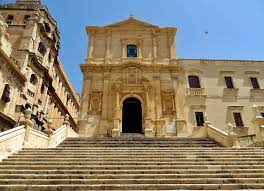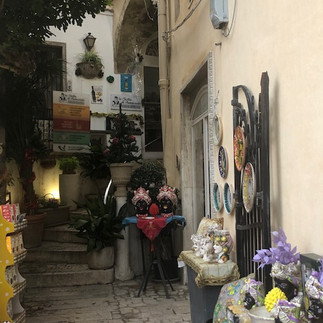Travel: Noto & Modica, Sicily, Italy Nov. 13/2022
- Lili Naveh
- Nov 13, 2022
- 7 min read
Updated: Nov 24, 2022
Part 3 of a trip to Sicily, (from Nov-10 - 16th)
Part 1 - Catania (Nov 9-10)
Part 2 - Syracuse (Nov 10-13)

After 3 fantastic days in Syracuse, the plan was to explore the Southerneast far tip of Sicily, starting with Noto which along with the neighboring towns of Ragusa, Modica and Scicli ,are part of a UNESCO Heritage Site.

David decided to drive South adjacent to the Ionian seaside, south of Avola - a small town, which we passed and which historically served a Tuna fishing port, dating back to a pre-Greek people called the Sicani.
The Greek colony here was established in the 8th BC, then the Romans arrived in 227 BC. The modern town and its beach are not that exciting, though it retains some old characteristic. The town's name is famous because of the wine dubbed after it - Nero d'Avola, a hearty red variety exported around the world
The Drive to Noto
Then we cut through the fields the 5 km to hwy S115 to NOTO, although the rental car GPS was “begging" - imploring ‘ us to make a U-TURN after thoroughly got us lost.
David is usually skeptical of WAZE and other GPS’s which is why the first thing we do when entering a country is to buy an old faithful paper map . However this time we followed the rental car GPS and Lo and behold, 10 minutes later we were driving on sideways unpaved rocks trails, of what maybe were previously paved roads or just dirt rock paths, crossing dry stream beds, driving along a narrow ancient rock walls that required us to fold the side mirrors or curve off into a dry small river, with no other human being in sight.
The rental car GPS continued to insist on a U-TURN all along , but by that time we had invested 30 minutes driving through the fields and decided not to turn back ..
First a mirage.. then in reality we finally saw a hwy about 2 km away direction NOTO, which would be our salvation , but no road to it and a totally confused GPS.
It was my idea to use Google map on my phone, which led us straight to the hwy.
In retrospect though quite adventurous, it was indeed a beautiful countryside drive with through orchards and vines and verdant hilly landscape
David's conclusions were:
"to always listen to your wife" ,
And GPS’s shouldn’t be trusted
The ancient city of Noto, 32 km southwest of the city of Syracuse, situated at the foot of the Iblean Mountains. was completely destroyed by the terrible 1693 Sicilian earthquake. and was rebuilt from scratch on a new site, about 10km from the old center, all late Baroque town planning and architecture.

Under the supervision of the Duke of Camastra, the Spanish Viceroy’s right-hand man, three architects, Labisi, Sinatra and Gagliardi, set to work, intent on creating a new town. plan with a linear, perfectly proportioned urban center, whose parallel lines would provide myriad panoramas.
A city of many many churches

The town was divided into 3 parts by three roads running from east to west, thus ensuring the constant attention of the sun.
At the top lived the nobility, in the middle the clergy, and at the bottom, hoi polloi.
The principal building material used was local compacted limestone, a substance that seemingly absorbs the sun’s aureate rays, and transforms them into a soft golden-honeyed glow. The effect at sunset is quite something.
A city is of Sicel origin, and was known as Netum in ancient times. In 263 BCE the city was granted to Hiero II by the Romans. According to legend, Daedalus stayed in the city after his flight over the Ionian Sea, as did Hercules after his seventh task. During the Roman era, it opposed the magistrate Verres.
In 866 it was conquered by the Muslims, who elevated the city to become a capital of one of the three districts of the island (the Val di Noto). In 1091, it became the last Islamic stronghold in Sicily to fall to the Christians.[5] Later it became a rich Norman city.

The main road is Corso Vittorio Emanuele along which many of Noto’s most representative buildings stand as well as public gardens , the Cathedral, and restaurants.
Also great Gelatto at this quint original
Quosque

Palazzo Ducrezio - Noto Town Hall.
This most impressive imposing palace in the heart of Noto is situated opposite the cathedral on the Piazza Municipio (halfway along the Corso Vittorio Emmanuelle).
is now used as Noto town hall.

The palace was designed by the architect Vincenzo Sinatra in 1746, inspired by some French palaces of the 17th c, but was completed only in 1830. The second floor of the palace was built in the first half of the 20th century by the architect Francesco La Grassa.
Main Cathedral San Nicolo of Mira

It is main religious building in the city erected between the 17th completed in 1776. In 1996 a disastrous collapse as a result of unremedied structural weakening caused by an earthquake in 1990, to which injudicious building alterations in the 1950s may have contributed, affected the dome and a large part of the roof , now rebuilt
With Adjacent Seminary Palazzo Nicolaci di Villadorata.

A city gate in Noto. Porta Reale is an entrance to the old city, built by the Marquis of Cannicarao at his own expense and designed by architect Orazio Angelici in 1838 for the arrival of King Ferdinand II of Bourbon in Noto,

Once a home to a Jewish Community
Noto was once home to a flourishing Jewish community which left the only known Sicilian siddur (prayer book); the book is now held at the Biblioteca Palatina in Parma
(ref: msparmense 1741/de’ Rossi 570).
The medieval Jewish quarter was also destroyed in 1693. There are still traces of the area’s Jewish past on the slope of Mount Alveria, in caves that were used as burial chambers. Some of these bear engravings depicting the menorah.

The best known is the Grotta del carciofo (‘Artichoke Cave’ – reflecting how the local peasants had interpreted the menorah image). It was discovered east of the Fiaccavento house near the former Porta della Montagna, north of where the old city had been.
The Noto Civic Archaeological Museum, contains a phylactery (charms) engraved on a limestone slab. It was found in 1940 on Mount Alveria, and dates from the 5th/6th c.
From Noto it is easy to reach the Ippari river valley, along which there are numerous underground Jewish burial chambers dating from the late classical period.
The City of Modica


About 15km out of Ragusa, the SS115 passes over the Viaduct 300m-high Guerrieri bridge from where the first glimpse of Modica, can be seen, deep down below, nestling at the bottom of the gorge being driving over and where the river which once snaked through-it is now Corso Umberto - the main Street .

We enjoyed getting oriented to this dramatic town , by riding the Green Choo Choo
hop on/hop off Train, which departs every from the main Corso Umberto St and easily squeeze its way through the narrow steep allies of the town in a loop.

Modica is another town, known for its Baroque architecture, and famous for its a 400-year tradition of Sicilian chocolate-making, and its famous classical musical composer
Pietro Floridia , born in 1860 in Modica.
Like the other towns in the historical and geographical Val di Noto, Modica was badly damaged in the 1693 earthquake and largely rebuilt in Sicilian Baroque style.
It is divided into 2 parts, “higher” Modica (where Chiesa di Santa Teresa d'Avila and Nuovo) and “lower” Modica, which are connected by numerous flights of steps.
Palazzi and houses rise from the bottom of the gorge seemingly stacked one on top of the other. Beautiful churches, with their inspiring domes, bell towers and intricate facades, in contrast to the red-tiled roofs .
Castle of Modica (1340)
“Castello dei Conti”


UNESCO Heritage glam Churches at the top of the Pizzo Hill
All were built on sites of an earlier constructed churches which were destroyed and rebuilt after the 17c earthquakes
Piazza Santa Teresa square top of Hill
Fans of the famous fictional Sicilian detective Inspector Montalbano, will recognize many of Modica's picturesque buildings, such as the Church of San Giorgio and the impressive façade of the Palazzo Polara, from the hit television series.
Chocolate Heaven
Being part of the Spanish kingdom for so many years meant that Sicily was often one of the first recipients of the new foodstuffs being brought back from South America.
Cacao was one of these and today Modica still specialises in making granulous chocolate, often flavored with chilli pepper, cinnamon or vanilla, that is based on Aztec methods and recipes. Chocolate shops abound and, for the real chocoholic, it is sometimes possible to watch the “chocolatiers” at work.

Casa Don Puglisi Restaurant
A great place on the main Corso Umberto, for chocolate, cookies
and wine.

The Old Jewish Getto of IL Cartellone

The County of Modica was one of the largest: the local Jewish community, which according to a census taken in 1492 was about a 20% of the whole Jewish population of the Island, and which contributed much to the wealth of the city. Jews used to live in a specific neighborhood in Modica, which has been known until today as “Il Cartellone” ( “the big posted sign”). Probably, at that time, a big sign used to indicate to the Christians where the Jewish quarter began: “Where the Jewish laws, attached to the street walls by the Jews, were noted.”.
A synagogue, of which, unfortunately, there is nothing left today, because of a terrible massacre that took place on August 15th 1474, once was there as well.
Locals who gathered in the Church of St. Mary of Bethlehem’s square, and headed for Il Cartellone attacked the community, killed about 360 Jews and ransacked the area.
Many years later, in 1492, the expulsion of the Jews from the Island. What remains of the ghetto today are narrow lanes and buildings arranged in a flounce pattern along the hill: Il Corso (“The Avenue”), which has been called “U Cursu” since that time, is integral part of the quarter and part of St. Peter’s Church, where an old Hebrew inscription on the vault of an arch overlooking a small alley can be seen.
In today's Il Cartellone quarter, artisan workshops, woodworkers, metalsmiths and tailors display their art and skills.
Walking up the streets of the quarter, to the Itria hill exposes amazing panoramic view of the city. More on Jewish history

Near Modica

The archaeological site of Cava d'Ispica, (the town of Ispica, about 12km southeast of Modica, ) is a green valley lined up with neolithic rock-cut burial tombs, and is easy to reach by car.
Just out of town, the golden sandy beach and its pedestrian promenade, at
Marina di Modica (20 km from Modica) and Sampieri seaside village are beautiful and relatively quiet outside August.


To be continued....






























































Comments